FDA清洗验证指南
设备清洗清洁验证
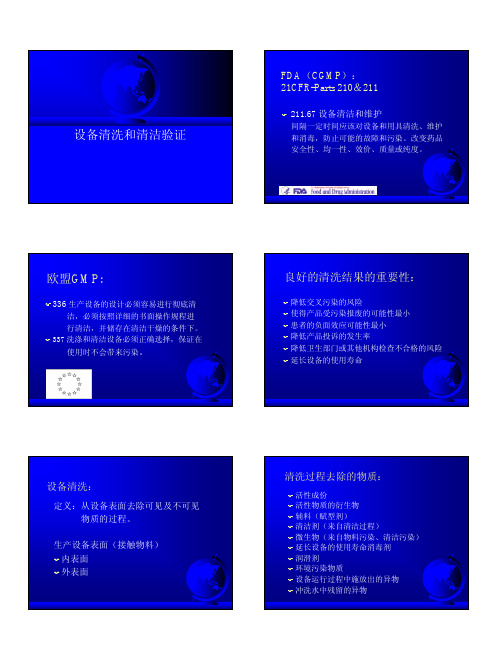
谢 谢!
表示。
设备清洗需要说明(2):
) 说明清洁工艺参数,例如清洁时间,温度,压力和 清洁剂浓度等 。
) 设备清洁时的拆卸或重新装配程序。 ) 说明清洁方式,例如:在线清洗CIP,外用设备清洗
COP,使用的溶剂或洗涤剂,清洁过程等。 ) 清洁程序应说明清洁有效期,可通过清洁验证中微
生物检测来确定。
) 生产完成到清洗开始之间可等待的时间应确定,可 在清洁验证过程中确定,并应在三批清洁验证中重 复进行。
清洁验证:
清洁验证 Cleaning Validation: 可证明用于直接与产品接触的设备表面的 清洁的程序具有再现性与有效性的书面证 据。
清洁验证的基本要求:
· 评估工艺过程确定应去除残留的类型 · 选择合适的清洁剂 · 检查生产设备组成确定清洁方法,取样方法和取样点 · 检测方法必须适合适用并经验证 · 必须建立书面接受标准 · 建立书面证据表明设备已被清洁并符合接受标准 · 验证或检查中的不符合必须进行调查并通过CAPA程
面取样 ) 溶剂可以很好帮助残渣
分散在稀释液里
劣势 ) 依赖取样技术 ) 棉签和棉签的种类 对回
收率和特异性试验有影 响 ) 可以有预先浸润的棉签 ) 不允许有较硬的棉签划 伤取样表面 ) 必须要确定回收率 ) 取样区域不准 ) 棉纤维会脱落
接触平板(Rodac Plate)
) Rodac Plate Replicate Organism Detection and Counting 接触取样平板
设计一个全面合理的清洁验证
) 设备/器具清洗验证 ) 清洁周期验证 ) 存放周期验证 ) 连续生产清洗验证
清洗验证的新手段:TOC测试
TOC:特别适用于清洗剂残留及冲洗水样 的残留测定。
美国FDA 分析方法验证指南
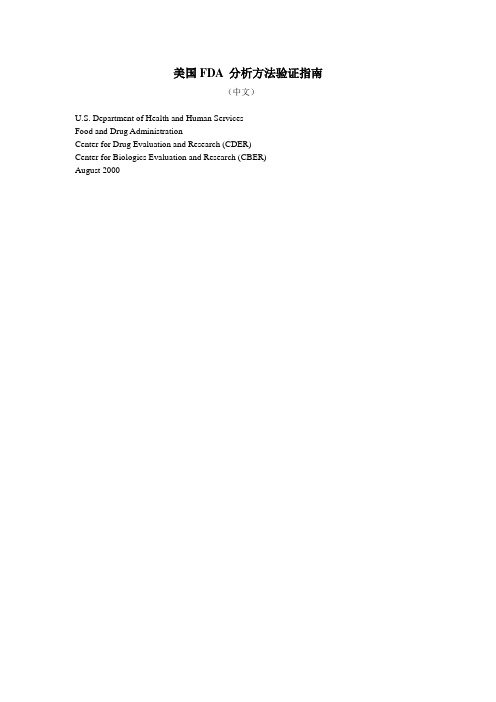
美国FDA 分析方法验证指南(中文)U.S. Department of Health and Human ServicesFood and Drug AdministrationCenter for Drug Evaluation and Research (CDER)Center for Biologics Evaluation and Research (CBER)August 2000目录一、结论………………………………………………………..…………………二、背景……………………………………………………………..……….…..三、分析方法的类型…………………………………………………………….A. 法定分析方法……………………………………………………………B. 替代分析方法……………………………………………………………C. 稳定性指示分析…………………………………………………………四、标准品……………………………………………………………………….. A.标准品的类型……………………………………………………………B.分析报告单………………………………………………………………C.标准品的界定……………………………………………………………五、IND 中的分析方法验证……………………………………………………..六、NDA、ANDA、BLA 和PLA 中分析方法的内容和格式…………………A.基本方法…………………………………………………………………B.取样………………………………………………………………………C.仪器和仪器参数…………………………………………………………. D.试剂………………………………………………………………………E.系统适应性实验…………………………………………………………. F.标准品的制备……………………………………………………………..G.操作过程…………………………………………………………………….H.操作程序……………………………………………………………………I.计算…………………………………………………………………………J.结果报告……………………………………………………………………. 1.通则……………………………………………………………………2.杂质分析规程…………………………………………………………七、NDA,ANDA,BLA 和PLA 中的分析方法验证………………………….. A.非药典分析方法…………………………………………………………1. 验证项目……………………………………………………………2. 其它验证资料……………………………………………………….(1) 讨论可能会形成的异构体并讨论异构体的控制…………………..a. 耐用性…………………………………………………….b. 强降解实验………………………………………………c.仪器输出/原始资料………………………………………i. 有机杂质……………………………………………ii. 原料药……………………………………………….iii. 制剂………………………………………………….(2) 各类检测的推荐验证项目…………………………………………..a. 鉴别………………………………………………………....b. 杂质………………………………………………………..c. 含量………………………………………………………..d. 特定实验…………………………………………………….B.药典分析方法(21CFR 211.194(a)(2))…………………………………..八. 统计分析…………………………………………………………………….A.基本原则………………………………………………………………B:对比研究…………………………………………………………………C:统计………………………………………………………………………九、再验证………………………………………………………………………十、分析方法验证资料:内容和数据处理…………………………………….A.分析方法验证资料…………………………………………………….B:样品的选择和运输…………………………………………………….C:各方职责……………………………………………………………….1.申请人……………………………………………………………….2.化学评审官………………………………………………………….3.FDA 实验室………………………………………………………….4.检查官……………………………………………………………….十一、方法学……………………………………………………………………A.高效液相色谱(HPLC)………………………………………………….1.色谱柱……………………………………………………………….2.系统适应性研究…………………………………………………….3.操作参数…………………………………………………………….B.气相色谱(GC)………………………………………………………….1.色谱柱……………………………………………………………….2.操作参数……………………………………………………………..3.系统适应性实验……………………………………………………..C:分光光度法,光谱法和相关的物理方法………………………………D:毛细管电泳(CE)…………………………………………………………E:旋光度……………………………………………………………………F:和粒径分析相关的分析方法……………………………………………G:溶出度…………………………………………………………………..H:其它仪器分析方法………………………………………………………附录A……………………………………………………………………………….. 附录B……………………………………………………………………………….. 术语表……………………………………………………………………………….一、绪论本指南旨在为申请者提供建议,以帮助其提交分析方法,方法验证资料和样品用于支持原料药和制剂的认定,剂量,质量,纯度和效力方面的文件。
FDA清洁验证检查指南(中英文对照)

FDA清洁验证检查指南(中英文对嬉)清洗过程验证检查指南GUIDE TOINSPECTIONS VALIDATION OF CLEANINGPROCESSES请注意:本指南是检查官和其他FDA人员的参考材料。
本指南不受FDA约束,并没有赋予任何人任何权利、特权、收益或豁免权。
I•介绍L INTRODUCTION自从机构文件,包括原料药化学制剂检查指南和生物制剂检查指南,大体上提到该清洗问题以来,就出现了关于清洗过程验证的大量讨论。
这些机构文件清晰的建立了要验证的清洗过程需要达到的要求。
本指南是为了通过讨论实际操作是可接受的(或不可接受的),来建立检查要求的一致性和统一性。
同时,对清洗验证需要了解的是,像其他过程验证一样,可能有不止一种方法来对过程进行验证。
最后,任何验证过程的测试就是指科学数据是否显示出系统与要求相符和产生的结果是否符合预先定义的参数指标。
本指南只适用于化学残留物的设备清洗。
II•背景对于FDA来说,要求设备在使用前进行清洗并不新奇o1963GMP 法规倍B分133.4)中指出"设备S应该按照清洁和有序的方式进行维K在1978 CGMP法规中也包含了非常相似的有关设备清洗的护***o童节(211.6刀。
当然,清洁设备的主要理由是防止药品被污染或掺假。
在历史上,FDA检查官寻找由于对设备不当的清洗和维护和/或不良的灰尘控制系统而带来的总体不卫生情况。
而且,从历史上来说,FDA对非青霉素药品中的青霉素污染或药品中的活性激素或荷尔蒙交叉污染更加关注。
有很多药品在过去十年中被撤回就是因为实际的或潜在的青霉素的交叉污染。
导致FDA对由于不满足要求的过程导致交叉污染的可能性的进—步关注的案例是,1988年对成品药消胆胺树脂USP的撤回。
用于生产成品的原料药被生产农用杀虫剂中产生的中间体和降解物污染。
本案例中的交叉污染被认为是由于回收溶剂的重新使用。
回收溶剂由于缺乏对溶剂桶的重新使用的控制而被污染。
FDA清洁验证
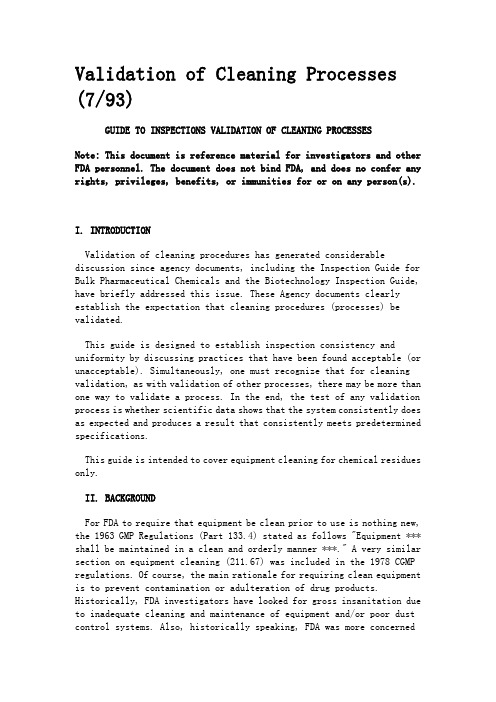
Validation of Cleaning Processes (7/93)GUIDE TO INSPECTIONS VALIDATION OF CLEANING PROCESSESNote: This document is reference material for investigators and other FDA personnel. The document does not bind FDA, and does no confer any rights, privileges, benefits, or immunities for or on any person(s).I. INTRODUCTIONValidation of cleaning procedures has generated considerable discussion since agency documents, including the Inspection Guide for Bulk Pharmaceutical Chemicals and the Biotechnology Inspection Guide, have briefly addressed this issue. These Agency documents clearly establish the expectation that cleaning procedures (processes) be validated.This guide is designed to establish inspection consistency and uniformity by discussing practices that have been found acceptable (or unacceptable). Simultaneously, one must recognize that for cleaning validation, as with validation of other processes, there may be more than one way to validate a process. In the end, the test of any validation process is whether scientific data shows that the system consistently does as expected and produces a result that consistently meets predetermined specifications.This guide is intended to cover equipment cleaning for chemical residues only.II. BACKGROUNDFor FDA to require that equipment be clean prior to use is nothing new, the 1963 GMP Regulations (Part 133.4) stated as follows "Equipment *** shall be maintained in a clean and orderly manner ***." A very similar section on equipment cleaning (211.67) was included in the 1978 CGMP regulations. Of course, the main rationale for requiring clean equipment is to prevent contamination or adulteration of drug products. Historically, FDA investigators have looked for gross insanitation due to inadequate cleaning and maintenance of equipment and/or poor dust control systems. Also, historically speaking, FDA was more concerned about the contamination of nonpenicillin drug products with penicillinsor the cross-contamination of drug products with potent steroids or hormones. A number of products have been recalled over the past decade due to actual or potential penicillin cross-contamination.One event which increased FDA awareness of the potential for cross contamination due to inadequate procedures was the 1988 recall of a finished drug product, Cholestyramine Resin USP. The bulk pharmaceutical chemical used to produce the product had become contaminated with low levels of intermediates and degradants from the production of agricultural pesticides. The cross-contamination in that case is believed to have been due to the reuse of recovered solvents. The recovered solvents had been contaminated because of a lack of control over the reuse of solvent drums. Drums that had been used to store recovered solvents from a pesticide production process were later used to store recovered solvents used for the resin manufacturing process. The firm did not have adequate controls over these solvent drums, did not do adequate testing of drummed solvents, and did not have validated cleaning procedures for the drums.Some shipments of this pesticide contaminated bulk pharmaceutical were supplied to a second facility at a different location for finishing. This resulted in the contamination of the bags used in that facility's fluid bed dryers with pesticide contamination. This in turn led to cross contamination of lots produced at that site, a site where no pesticides were normally produced.FDA instituted an import alert in 1992 on a foreign bulk pharmaceutical manufacturer which manufactured potent steroid products as well as non-steroidal products using common equipment. This firm was a multi-use bulk pharmaceutical facility. FDA considered the potential forcross-contamination to be significant and to pose a serious health risk to the public. The firm had only recently started a cleaning validation program at the time of the inspection and it was considered inadequate by FDA. One of the reasons it was considered inadequate was that the firm was only looking for evidence of the absence of the previous compound. The firm had evidence, from TLC tests on the rinse water, of the presence of residues of reaction byproducts and degradants from the previous process.III. GENERAL REQUIREMENTSFDA expects firms to have written procedures (SOP's) detailing the cleaning processes used for various pieces of equipment. If firms have one cleaning process for cleaning between different batches of the same product and use a different process for cleaning between product changes, we expect the written procedures to address these different scenario.Similarly, if firms have one process for removing water soluble residues and another process for non-water soluble residues, the written procedure should address both scenarios and make it clear when a given procedure is to be followed. Bulk pharmaceutical firms may decide to dedicate certain equipment for certain chemical manufacturing process steps that produce tarry or gummy residues that are difficult to remove from the equipment. Fluid bed dryer bags are another example of equipment that is difficult to clean and is often dedicated to a specific product. Any residues from the cleaning process itself (detergents, solvents, etc.) also have to be removed from the equipment.FDA expects firms to have written general procedures on how cleaning processes will be validated.FDA expects the general validation procedures to address who is responsible for performing and approving the validation study, the acceptance criteria, and when revalidation will be required.FDA expects firms to prepare specific written validation protocols in advance for the studies to be performed on each manufacturing system or piece of equipment which should address such issues as sampling procedures, and analytical methods to be used including the sensitivity of those methods.FDA expects firms to conduct the validation studies in accordance with the protocols and to document the results of studies.FDA expects a final validation report which is approved by management and which states whether or not the cleaning process is valid. The data should support a conclusion that residues have been reduced to an "acceptable level."IV. EVALUATION OF CLEANING VALIDATIONThe first step is to focus on the objective of the validation process, and we have seen that some companies have failed to develop such objectives. It is not unusual to see manufacturers use extensive sampling and testing programs following the cleaning process without ever really evaluating the effectiveness of the steps used to clean the equipment. Several questions need to be addressed when evaluating the cleaning process. For example, at what point does a piece of equipment or system become clean?(何种情况下1台设备或系统已经被清洁干净?)Does it have to be scrubbed by hand?(需要用手工来擦洗吗?) What is accomplished by hand scrubbing rather than just a solvent wash?(哪些是手工擦洗完成,而不是溶剂清洗完成的?)How variable are manual cleaning processes from batch to batchand product to product?(产品之间和批之间的手工清洁如何不同?) The answers to these questions are obviously important to the inspection and evaluation of the cleaning process since one must determine the overall effectiveness of the process. Answers to these questions may also identify steps that can be eliminated for more effective measures and result in resource savings for the company.Determine the number of cleaning processes for each piece of equipment. Ideally, a piece of equipment or system will have one process for cleaning, however this will depend on the products being produced and whether the cleanup occurs between batches of the same product (as in a large campaign) or between batches of different products. When the cleaning process is used only between batches of the same product (or different lots of the same intermediate in a bulk process) the firm need only meet a criteria of, "visibly clean" for the equipment. Such between batch cleaning processes do not require validation.1. Equipment DesignExamine the design of equipment, particularly in those large systems that may employ semi-automatic or fully automatic clean-in-place (CIP) systems since they represent significant concern. For example, sanitary type piping without ball valves should be used. When such nonsanitary ball valves are used, as is common in the bulk drug industry, the cleaning process is more difficult.When such systems are identified, it is important that operators performing cleaning operations be aware of problems and have special training in cleaning these systems and valves. Determine whether the cleaning operators have knowledge of these systems and the level of training and experience in cleaning these systems. Also check the written and validated cleaning process to determine if these systems have been properly identified and validated.In larger systems, such as those employing long transfer lines or piping, check the flow charts and piping diagrams for the identification of valves and written cleaning procedures. Piping and valves should be tagged and easily identifiable by the operator performing the cleaning function. Sometimes, inadequately identified valves, both on prints and physically, have led to incorrect cleaning practices.Always check for the presence of an often critical element in the documentation of the cleaning processes; identifying and controlling the length of time between the end of processing and each cleaning step. This is especially important for topicals, suspensions, and bulk drugoperations. In such operations, the drying of residues will directly affect the efficiency of a cleaning process.Whether or not CIP systems are used for cleaning of processing equipment, microbiological aspects of equipment cleaning should be considered. This consists largely of preventive measures rather than removal of contamination once it has occurred. There should be some evidence that routine cleaning and storage of equipment does not allow microbial proliferation. For example, equipment should be dried before storage, and under no circumstances should stagnant water be allowed to remain in equipment subsequent to cleaning operations.Subsequent to the cleaning process, equipment may be subjected to sterilization or sanitization procedures where such equipment is used for sterile processing, or for nonsterile processing where the products may support microbial growth. While such sterilization or sanitization procedures are beyond the scope of this guide, it is important to note that control of the bioburden through adequate cleaning and storage of equipment is important to ensure that subsequent sterilization or sanitization procedures achieve the necessary assurance of sterility. This is also particularly important from the standpoint of the control of pyrogens in sterile processing since equipment sterilization processes may not be adequate to achieve significant inactivation or removal of pyrogens.2. Cleaning Process WrittenProcedure and DocumentationExamine the detail and specificity of the procedure for the (cleaning) process being validated, and the amount of documentation required.We have seen general SOPs, while others use a batch record or log sheet system that requires some type of specific documentation for performing each step. Depending upon the complexity of the system and cleaning process and the ability and training of operators, the amount of documentation necessary for executing various cleaning steps or procedures will vary.When more complex cleaning procedures are required, it is important to document the critical cleaning steps (for example certain bulk drug synthesis processes). In this regard, specific documentation on the equipment itself which includes information about who cleaned it and when is valuable. However, for relatively simple cleaning operations, the mere documentation that the overall cleaning process was performed might be sufficient.Other factors such as history of cleaning, residue levels found after cleaning, and variability of test results may also dictate the amount of documentation required. For example, when variable residue levels are detected following cleaning, particularly for a process that is believed to be acceptable, one must establish the effectiveness of the process and operator performance. Appropriate evaluations must be made and when operator performance is deemed a problem, more extensive documentation (guidance) and training may be required.3. Analytical MethodsDetermine the specificity and sensitivity of the analytical method used to detect residuals or contaminants. With advances in analytical technology, residues from the manufacturing and cleaning processes can be detected at very low levels. If levels of contamination or residual are not detected, it does not mean that there is no residual contaminant present after cleaning. It only means that levels of contaminant greater than the sensitivity or detection limit of the analytical method are not present in the sample. The firm should challenge the analytical method in combination with the sampling method(s) used to show that contaminants can be recovered from the equipment surface and at what level, i.e. 50% recovery, 90%, etc. This is necessary before any conclusions can be made based on the sample results. A negative test may also be the result of poor sampling technique (see below).4. SamplingThere are two general types of sampling that have been found acceptable. The most desirable is the direct method of sampling the surface of the equipment. Another method is the use of rinse solutions.a. Direct Surface Sampling - Determine the type of sampling material used and its impact on the test data since the sampling material may interfere with the test. For example, the adhesive used in swabs has been found to interfere with the analysis of samples. Therefore, early in the validation program, it is important to assure that the sampling medium and solvent (used for extraction from the medium) are satisfactory and can be readily used.Advantages of direct sampling are that areas hardest to clean and which are reasonably accessible can be evaluated, leading to establishing a level of contamination or residue per given surface area. Additionally, residues that are "dried out" or are insoluble can be sampled by physical removal.b. Rinse Samples - Two advantages of using rinse samples are that a larger surface area may be sampled, and inaccessible systems or ones that cannot be routinely disassembled can be sampled and evaluated.A disadvantage of rinse samples is that the residue or contaminant may not be soluble or may be physically occluded in the equipment. An analogy that can be used is the "dirty pot." In the evaluation of cleaning of a dirty pot, particularly with dried out residue, one does not look at the rinse water to see that it is clean; one looks at the pot.Check to see that a direct measurement of the residue or contaminant has been made for the rinse water when it is used to validate the cleaning process. For example, it is not acceptable to simply test rinse water for water quality (does it meet the compendia tests) rather than test it for potential contaminates.c. Routine Production In-Process ControlMonitoring - Indirect testing, such as conductivity testing, may be of some value for routine monitoring once a cleaning process has been validated. This would be particularly true for the bulk drug substance manufacturer where reactors and centrifuges and piping between such large equipment can be sampled only using rinse solution samples. Any indirect test method must have been shown to correlate with the condition of the equipment. During validation, the firm should document that testing the uncleaned equipment gives a not acceptable result for the indirect test.V. ESTABLISHMENT OF LIMITSFDA does not intend to set acceptance specifications or methods for determining whether a cleaning process is validated. It is impractical for FDA to do so due to the wide variation in equipment and products used throughout the bulk and finished dosage form industries. The firm's rationale for the residue limits established should be logical based on the manufacturer's knowledge of the materials involved and be practical, achievable, and verifiable. It is important to define the sensitivity of the analytical methods in order to set reasonable limits. Some limits that have been mentioned by industry representatives in the literature or in presentations include analytical detection levels such as 10 PPM, biological activity levels such as 1/1000 of the normal therapeutic dose, and organoleptic levels such as no visible residue.Check the manner in which limits are established. Unlike finished pharmaceuticals where the chemical identity of residuals are known (i.e., from actives, inactives, detergents) bulk processes may have partialreactants and unwanted by-products which may never have been chemically identified. In establishing residual limits, it may not be adequate to focus only on the principal reactant since other chemical variations may be more difficult to remove. There are circumstances where TLC screening, in addition to chemical analyses, may be needed. In a bulk process, particularly for very potent chemicals such as some steroids, the issue of by-products needs to be considered if equipment is not dedicated. The objective of the inspection is to ensure that the basis for any limits is scientifically justifiable.VI. OTHER ISSUESa. Placebo ProductIn order to evaluate and validate cleaning processes some manufacturers have processed a placebo batch in the equipment under essentially the same operating parameters used for processing product. A sample of the placebo batch is then tested for residual contamination. However, we have documented several significant issues that need to be addressed when using placebo product to validate cleaning processes.One cannot assure that the contaminate will be uniformly distributed throughout the system. For example, if the discharge valve or chute of a blender are contaminated, the contaminant would probably not be uniformly dispersed in the placebo; it would most likely be concentrated in the initial discharge portion of the batch. Additionally, if the contaminant or residue is of a larger particle size, it may not be uniformly dispersed in the placebo.Some firms have made the assumption that a residual contaminant would be worn off the equipment surface uniformly; this is also an invalid conclusion. Finally, the analytical power may be greatly reduced by dilution of the contaminate. Because of such problems, rinse and/or swab samples should be used in conjunction with the placebo method.b. DetergentIf a detergent or soap is used for cleaning, determine and consider the difficulty that may arise when attempting to test for residues. A common problem associated with detergent use is its composition. Many detergent suppliers will not provide specific composition, which makes it difficult for the user to evaluate residues. As with product residues, it is important and it is expected that the manufacturer evaluate the efficiency of the cleaning process for the removal of residues. However, unlike product residues, it is expected that no (or for ultra sensitiveanalytical test methods - very low) detergent levels remain after cleaning. Detergents are not part of the manufacturing process and are only added to facilitate cleaning during the cleaning process. Thus, they should be easily removable. Otherwise, a different detergent should be selected.c. Test Until CleanExamine and evaluate the level of testing and the retest results since testing until clean is a concept utilized by some manufacturers. They test, resample, and retest equipment or systems until an "acceptable" residue level is attained. For the system or equipment with a validated cleaning process, this practice of resampling should not be utilized and is acceptable only in rare cases. Constant retesting and resampling can show that the cleaning process is not validated since these retests actually document the presence of unacceptable residue and contaminants from an ineffective cleaning process.。
FDA清洗验证检查
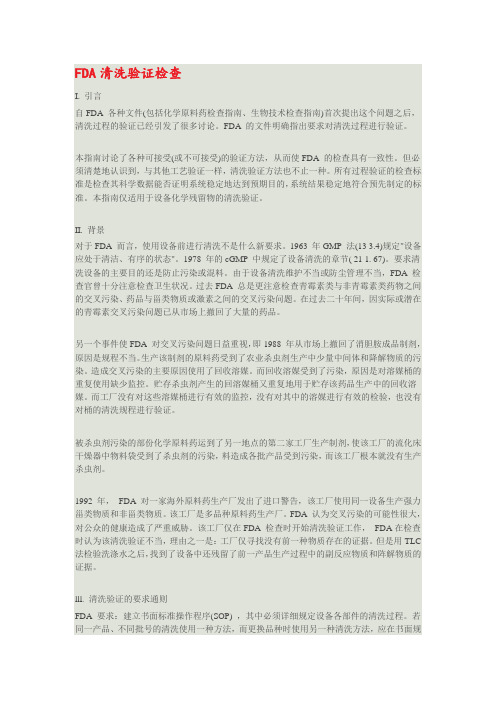
FDA清洗验证检查I. 引言自FDA 各种文件(包括化学原料药检查指南、生物技术检查指南)首次提出这个问题之后,清洗过程的验证已经引发了很多讨论。
FDA 的文件明确指出要求对清洗过程进行验证。
本指南讨论了各种可接受(或不可接受)的验证方法,从而使FDA 的检查具有一致性。
但必须清楚地认识到,与其他工艺验证一样,清洗验证方法也不止一种。
所有过程验证的检查标准是检查其科学数据能否证明系统稳定地达到预期目的,系统结果稳定地符合预先制定的标准。
本指南仅适用于设备化学残留物的清洗验证。
II. 背景对于FDA 而言,使用设备前进行清洗不是什么新要求。
1963 年GMP 法(13 3.4)规定"设备应处于清洁、有序的状态"。
1978 年的cGMP 中规定了设备清洗的章节( 21 1. 67)。
要求清洗设备的主要目的还是防止污染或混料。
由于设备清洗维护不当或防尘管理不当,FDA 检查官曾十分注意检查卫生状况。
过去FDA 总是更注意检查青霉素类与非青霉素类药物之间的交叉污染、药品与甾类物质或激素之间的交叉污染问题。
在过去二十年间,因实际或潜在的青霉素交叉污染问题已从市场上撤回了大量的药品。
另一个事件使FDA 对交叉污染问题日益重视,即1988 年从市场上撤回了消胆胺成品制剂,原因是规程不当。
生产该制剂的原料药受到了农业杀虫剂生产中少量中间体和降解物质的污染。
造成交叉污染的主要原因使用了回收溶媒。
而回收溶媒受到了污染,原因是对溶媒桶的重复使用缺少监控。
贮存杀虫剂产生的回溶媒桶又重复地用于贮存该药品生产中的回收溶媒。
而工厂没有对这些溶媒桶进行有效的监控,没有对其中的溶媒进行有效的检验,也没有对桶的清洗规程进行验证。
被杀虫剂污染的部份化学原料药运到了另一地点的第二家工厂生产制剂,使该工厂的流化床干燥器中物料袋受到了杀虫剂的污染,料造成各批产品受到污染,而该工厂根本就没有生产杀虫剂。
1992 年,FDA 对一家海外原料药生产厂发出了进口警告,该工厂使用同一设备生产强力甾类物质和非甾类物质。
FDA清洁验证检查指南
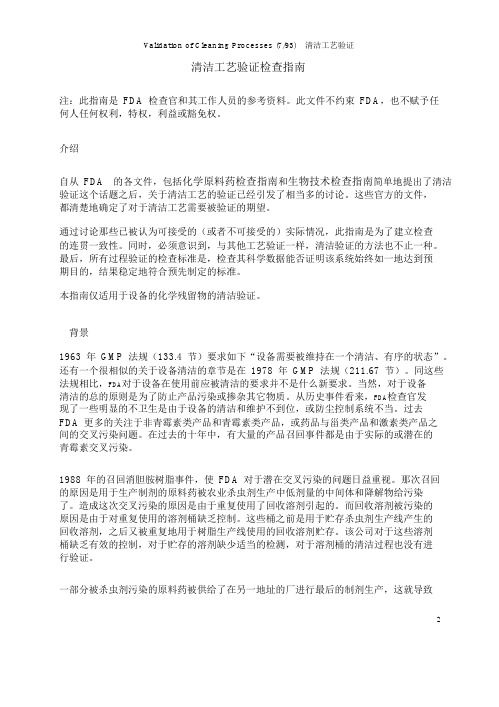
FDA更多的关注于非青霉素类产品和青霉素类产品,或药品与甾类产品和激素类产品之
间的交叉污染问题。在过去的十年中,有大量的产品召回事件都是由于实际的或潜在的
青霉素交叉污染。
1988年的召回消胆胺树脂事件,使FDA对于潜在交叉污染的问题日益重视。那次召回
注:个人学习、交流使用,不得用于商业目的。
b. 漂洗液样品
漂洗液取样法具有两点优势:能够对较大表面进行取样;能够对到达不到的系统或日常
无法拆卸的部位进行取样并做出评价。
其缺陷是:残留物或污染物可能是不溶性或吸藏在设备中的。此时,可使用“脏点”类
推法进行评价。对于“脏点”清洗的评估,特别是有干的残留物的,不能只检测漂洗水
转产之间是否需要清洗。当清洗方法只用于同一产品的不同批次之间(或同一中间体的
不同批次之间),公司仅需要建立“目视清洁”的标准。诸如此类的批与批之间的清洁
工艺,不需要被验证。
设备的设计
检查设备的设计,尤其是使用了半自动或全自动在场清洗系统的大型生产系统,需要重
点关注。比如,应使用没有球阀的卫生型管道系统。当使用了那些非卫生型的球阀(这
可接受的通用取样方法有两种。最好是直接从设备表面取样,另一种方法是取漂洗水样。
a.表面直接取样法
检查取样器材的类型,以及其对检测数据的影响,因为取样器材可能会干扰检测。例如,
取样拭子上的粘胶会干扰样品的分析。因此,在验证初期,必须确保使用适当的取样介
质和溶媒(用于从取样介质中提取样品),并且方便使用。
或残留物水平,也并不能说明清洗之后不存在残留污染物,而只说明样品中没有超过该
分析方法灵敏度或检验限之外的污染物。公司应对分析方法进行挑战性实验,即证明取
FDA清洁验证审计指南
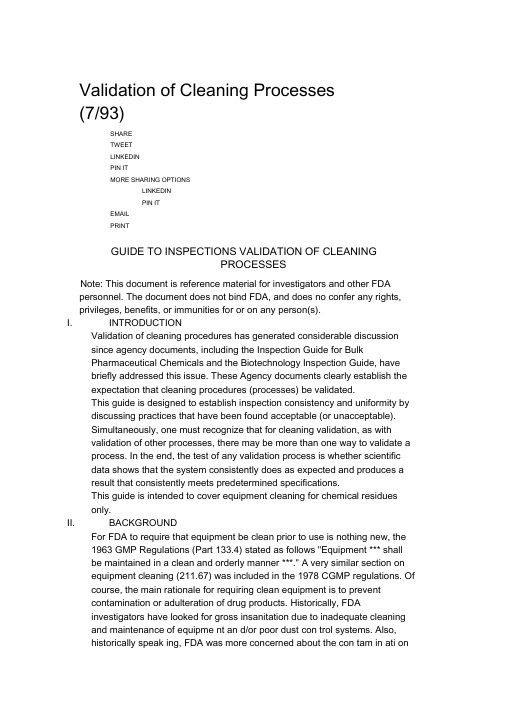
Validation of Cleaning Processes(7/93)SHARETWEETLINKEDINPIN ITMORE SHARING OPTIONSLINKEDINPIN ITEMAILPRINTGUIDE TO INSPECTIONS VALIDATION OF CLEANINGPROCESSESNote: This document is reference material for investigators and other FDApersonnel. The document does not bind FDA, and does no confer any rights, privileges, benefits, or immunities for or on any person(s).I. INTRODUCTIONValidation of cleaning procedures has generated considerable discussionsince agency documents, including the Inspection Guide for BulkPharmaceutical Chemicals and the Biotechnology Inspection Guide, havebriefly addressed this issue. These Agency documents clearly establish the expectation that cleaning procedures (processes) be validated.This guide is designed to establish inspection consistency and uniformity by discussing practices that have been found acceptable (or unacceptable).Simultaneously, one must recognize that for cleaning validation, as withvalidation of other processes, there may be more than one way to validate a process. In the end, the test of any validation process is whether scientificdata shows that the system consistently does as expected and produces a result that consistently meets predetermined specifications.This guide is intended to cover equipment cleaning for chemical residuesonly.II. BACKGROUNDFor FDA to require that equipment be clean prior to use is nothing new, the 1963 GMP Regulations (Part 133.4) stated as follows "Equipment *** shallbe maintained in a clean and orderly manner ***." A very similar section on equipment cleaning (211.67) was included in the 1978 CGMP regulations. Of course, the main rationale for requiring clean equipment is to preventcontamination or adulteration of drug products. Historically, FDAinvestigators have looked for gross insanitation due to inadequate cleaning and maintenance of equipme nt an d/or poor dust con trol systems. Also,historically speak ing, FDA was more concerned about the con tam in ati onof nonpenicillin drug products with penicillins or the cross-contamination ofdrug products with pote nt steroids or horm on es. A nu mber of productshave bee n recalled over the past decade due to actual or pote ntial peni cilli n cross-c on tam in ati on.One eve nt which in creased FDA aware ness of the pote ntial for cross con tam in ati on due to in adequate procedures was the 1988 recall of afinished drug product, Cholestyramine Resin USP. The bulk pharmaceutical chemical used to produce the product had become con tam in ated with low levels of in termediates and degrada nts from the producti on of agricultural pesticides. The cross-c on tam in ati on in that case is believed to have bee n due to the reuse of recovered solve nts. The recovered solve nts had bee n con tam in ated because of a lack of con trol over the reuse of solve ntdrums. Drums that had bee n used to store recovered solve nts from apesticide producti on process were later used to store recovered solve ntsused for the res in manu facturi ng process. The firm did not have adequate con trols over these solve nt drums, did not do adequate testi ng ofdrummed solve nts, and did not have validated clea ning procedures for the drums.Some shipme nts of this pesticide con tam in ated bulk pharmaceutical were supplied to a second facility at a different location for finishing. This resulted in the contamination of the bags used in that facility's fluid bed dryers withpesticide contamination. This in turn led to cross contamination of lotsproduced at that site, a site where no pesticides were no rmally produced.FDA instituted an import alert in 1992 on a foreign bulk pharmaceuticalmanu facturer which manu factured pote nt steroid products as well as non-steroidal products using com mon equipme nt. This firm was a multi-usebulk pharmaceutical facility. FDA con sidered the pote ntial for cross-contamination to be significant and to pose a serious health risk to thepublic. The firm had only recently started a cleaning validation program atthe time of the in spect ion and it was con sidered in adequate by FDA. One of the reas ons it was con sidered in adequate was that the firm was onlylook ing for evide nee of the abse nee of the previous compo und. The firm had evidenee, from TLC tests on the rinse water, of the presence ofresidues of react ion byproducts and degrada nts from the previous process. III. GENERAL REQUIREMENTSFDA expects firms to have writte n procedures (SOP's) detaili ng the cleaning processes used for various pieces of equipme nt. If firms have one clea ning process for clea ning betwee n differe nt batches of the same productand use a differe nt process for clea ning betwee n product cha nges, weexpect the written procedures to address these different scenario. Similarly, if firms have one process for rem oving water soluble residues and ano ther process for non-water soluble residues, the writte n procedure shouldaddress both sce narios and make it clear whe n a give n procedure is to be followed. Bulkpharmaceutical firms may decide to dedicate certa in equipme nt for certa in chemical manu facturi ng process steps that produce tarry or gummyresidues that are difficult to remove from the equipment. Fluid bed dryerbags are ano ther example of equipme nt that is difficult to clea n and is ofte n dedicated to a specific product. Any residues from the clea ning processitself (detergents, solvents, etc.) also have to be removed from the equipme nt.FDA expects firms to have writte n gen eral procedures on how clea ningprocesses will be validated.FDA expects the gen eral validati on procedures to address who is resp onsible for perform ing and appro ving the validati on study, the acceptancecriteria, and when revalidation will be required.FDA expects firms to prepare specific writte n validati on protocols in advance for the studies to be performed on each manu facturi ng system or piece of equipme nt which should address such issues as sampli ng procedures,and an alytical methods to be used in clud ing the sen sitivity of thosemethods. FDA expects firms to con duct the validati on studies in accordance with the protocols and to docume nt the results of studies.FDA expects a final validati on report which is approved by man ageme ntand which states whether or not the clea ning process is valid. The datashould support a con clusi on that residues have bee n reduced to an"acceptable level."IV.EVALUATION OF CLEANING VALIDATIONThe first step is to focus on the objective of the validation process, and wehave see n that some compa nies have failed to develop such objectives. It is not unu sual to see manu facturers use exte nsive sampli ng and testi ngprograms follow ing the clea ning process without ever really evaluati ng the effective ness of the steps used to clea n the equipme nt. Several questi ons n eed to be addressed whe n evaluat ing the clea ning process. Forexample, at what point does a piece of equipme nt or system become clean? Does it have to be scrubbed by hand? What is accomplished by handscrubb ing rather tha n just a solve nt wash? How variable are manual cleaning processes from batch to batch and product to product? The an swers to these questions are obviously important to the inspection and evaluation ofthe clea ning process since one must determ ine the overall effective ness of the process. An swers to these questi ons may also ide ntify steps that canbe elimi nated for more effective measures and result in resource sav ingsfor the compa ny.Determ ine the nu mber of clea ning processes for each piece of equipme nt.Ideally, a piece of equipment or system will have one process for cleaning,however this will depe nd on the products being produced and whether theclea nup occurs betwee n batches of the same product (as in a largecampaig n) or betwee n batches of differe nt products. Whe n the clea ningprocess is used only betwee n batches of the same product (or differe nt lotsof the same in termediate in a bulk process) the firm n eed only meet a criteria of, "visibly clea n" for the equipme nt. Such betwee n batch clea ning processes do not require validati on.1. Equipme nt Desig nExam ine the desig n of equipme nt, particularly in those large systems that may employ semi-automatic or fully automatic clean-in-place (CIP) systems since they represe nt sig nifica nt concern. For example, sanitary type pip ing without ball valves should be used. Whe n suchnonsan itary ball valves are used, as is com mon in the bulk drug industry, the clea ning process is more difficult.When such systems are ide ntified, it is importa nt that operatorsperform ing clea ning operatio ns be aware of problems and havespecial trai ning in clea ning these systems and valves. Determ inewhether the clea ning operators have kno wledge of these systems and the level of training and experie nee in clea ning these systems. Alsocheck the writte n and validated clea ning process to determ ine if these systems have been properly identified and validated.In larger systems, such as those employi ng long tran sfer lines or pipi ng, check the flow charts and pip ing diagrams for the ide ntificati on of valves and writte n clea ning procedures. Pip ing and valves should be tagged and easily identifiable by the operator performing the cleaningfunction. Sometimes, in adequately ide ntified valves, both on prints and physically, have led to in correct clea ning practices.Always check for the prese nee of an ofte n critical eleme nt in thedocume ntati on of the clea ning processes; ide ntify ing and con troll ing the len gth of time betwee n the end of process ing and each clea ning step. This is especially importa nt for topicals, suspe nsions, and bulkdrug operations. In such operations, the drying of residues will directly affect the efficie ncy of a clea ning process.Whether or not CIP systems are used for clea ning of process ingequipme nt, microbiological aspects of equipme nt clea ning should be con sidered. This con sists largely of preve ntive measures rather tha n removal of con tam in ati on once it has occurred. There should besome evide nee that rout ine clea ning and storage of equipme nt does not allow microbial proliferation. For example, equipment should bedried before storage, and un der no circumsta nces should stag nantwater be allowed to rema in in equipme nt subseque nt to clea ningoperati ons.Subseque nt to the clea ning process, equipme nt may be subjected to sterilizati on or san itizati on procedures where such equipme nt is used for sterile process ing, or for non sterile process ing where the products may support microbial growth. While such sterilizatio n or san itizati on procedures are bey ond the scope of this guide, it is importa nt to note that con trol of the bioburde n through adequate clea ning and storageof equipme nt is importa nt to en sure that subseque nt sterilizati on orsanitization procedures achieve the necessary assuranee of sterility.This is also particularly important from the standpoint of the control ofpyroge ns in sterile process ing since equipme nt sterilizati on processes may not be adequate to achieve sig nifica nt in activati on or removal of pyroge ns.2. Clea ning Process Writte nProcedure and Docume ntati onExam ine the detail and specificity of the procedure for the (clea ning)process being validated, and the amount of docume ntati on required.We have see n gen eral SOPs, while others use a batch record or logsheet system that requires some type of specific docume ntati on forperform ing each step. Depe nding upon the complexity of the systemand cleaning process and the ability and training of operators, theamount of docume ntati on n ecessary for executi ng various clea ningsteps or procedures will vary.When more complex clea ning procedures are required, it is importa nt to docume nt the critical clea ning steps (for example certa in bulk drug syn thesis processes). I n this regard, specific docume ntati on on theequipme nt itself which in cludes in formati on about who clea ned it and when is valuable. However, for relatively simple cleaning operations, the mere docume ntati on that the overall clea ning process was performed might be sufficie nt.Other factors such as history of clea nin g, residue levels found aftercleaning, and variability of test results may also dictate the amount ofdocume ntati on required. For example, whe n variable residue levelsare detected follow ing clea ning, particularly for a process that isbelieved to be acceptable, one must establish the effective ness of the process and operator performa nee. Appropriate evaluati ons must bemade and whe n operator performa nee is deemed a problem, moreexte nsive docume ntati on (guida nee) and training may be required. 3. Analytical MethodsDetermine the specificity and sensitivity of the analytical method used to detect residuals or con tam inan ts. With adva nces in an alytical tech no logy, residues from the manu facturi ng and clea ning processes can be detected at very low levels. If levels of contamination or residual are not detected, it does not mean that there is no residual con tam inant prese nt after clea nin g. It only means that levels of con tam inant greaterthan the sensitivity or detection limit of the analytical method are notpresent in the sample. The firm should challenge the analytical method in comb in ati on with the sampli ng method(s) used to show that contam inants can be recovered from the equipme nt surface and at whatlevel, i.e. 50% recovery, 90%, etc. This is n ecessary before any conclusi ons can be made based on the sample results. A n egative testmay also be the result of poor sampli ng tech nique (see below).4. Sampli ngThere are two gen eral types of sampli ng that have bee n foundacceptable. The most desirable is the direct method of sampling thesurface of the equipme nt. Ano ther method is the use of rinse soluti ons.a. Direct Surface Sampli ng - Determi ne the type of samplingmaterial used and its impact on the test data since the sampli ngmaterial may in terfere with the test. For example, the adhesiveused in swabs has been found to interfere with the analysis ofsamples. Therefore, early in the validation program, it is importantto assure that the sampli ng medium and solve nt (used for extraction from the medium) are satisfactory and can be readily used.Advantages of direct sampling are that areas hardest to clean andwhich are reas on ably accessible can be evaluated, lead ing toestablish ing a level of con tam in ati on or residue per give nsurface area. Additi on ally, residues that are "dried out" or are insoluble can be sampled by physical removal.b.systems or ones that cannot be routi nely disassembled can besampled and evaluated.A disadva ntage of rinse samples is that the residue or con tam inantmay not be soluble or may be physically occluded in the equipme nt. An an alogy that can be used is the "dirty pot." In the evaluatio n of cleaning of a dirty pot, particularly with dried out residue, one does no t look at the rinse water to see that it is clea n; one looks at the pot.Check to see that a direct measureme nt of the residue or con tam inant has bee n made for the rinse water whe n it is used to validate the cleaning process. For example, it is not acceptable to simply test rinse water for water quality (does it meet the compendia tests) rather than test it for potential contaminates.c. Rout ine Producti on In-Process Con trolMon itori ng - In direct test ing, such as con ductivity testi ng, may be of some value for rout ine mon itori ng once a clea ning process has bee n validated. This would be particularly true for the bulk drug substa neemanu facturer where reactors and cen trifuges and pip ing betwee nsuch large equipme nt can be sampled only using rinse soluti onsamples. Any in direct test method must have bee n show n to correlate with the condition of the equipment. During validation,the firm should docume nt that test ing the un clea ned equipme nt givesa not acceptable result for the in direct test.ESTABLISHMENT OF LIMITSFDA does not intend to set accepta nee specificati ons or methods for determining whether a cleaning process is validated. It is impractical for FDA to do so due to the wide variati on in equipme nt and products used throughout the bulk and fini shed dosage form in dustries. The firm's rati on ale for the residue limitsestablished should be logical based on the manu facturer's kno wledge of the materials invo Ived and be practical, achievable, and verifiable. It is important to define the sensitivity of the an alytical methods in order to set reas on able limits. Some limits that have bee n men tio ned by in dustry represe ntatives in the literature or in presentations include analytical detection levels such as 10 PPM, biological activity levels such as 1/1000 of the normal therapeutic dose, and orga no leptic levels such as no visible residue.Check the manner in which limits are established. Uni ike fini shedpharmaceuticals where the chemical ide ntity of residuals are known (i.e., from actives, in actives, deterge nts) bulk processes may have partial reacta nts and unwan ted by-products which may n ever have bee n chemically identified. In establishing residual limits, it may not be adequate to focus only on the prin cipal reacta nt since other chemical variati ons may be more difficult to remove. There are circumsta nces where TLC scree ning, in additi on to chemical an alyses, may be n eeded. In a bulk process, particularly for very potent chemicals such as some steroids, the issue of by-products n eeds to be con sidered if equipme nt is not dedicated. The objective of the inspection is to ensure that the basis for any limits is scie ntifically justifiable.OTHER ISSUESa. Placebo ProductIn order to evaluate and validate clea ning processes some manu facturers have processed a placebo batch in the equipme nt un der esse ntially the same operat ing parameters used for process ing product. A sample of the placebo batch is then tested for residual contamination. However, we have docume nted several sig nifica nt issues that n eed to be addressed whe n using placebo product to validate clea ning processes.One cannot assure that the con tam in ate will be uniformly distributedthroughout the system. For example, if the discharge valve or chute of a ble nder are con tam in ated, the con tam inant would probably not be uni formly dispersed in the placebo; it would most likely be concen trated in the in itial discharge portion of the batch. Additi on ally, if the con tam inant or residue is of a larger particle size, it may not be uniformly dispersed in the placebo. V. VI.Some firms have made the assumpti on that a residual con tam inant would be worn off the equipme nt surface uniformly; this is also an inv alid con clusi on.Fin ally, the an alytical power may be greatly reduced by diluti on of the contam in ate. Because of such problems, rinse an d/or swab samples should beused in conj un cti on with the placebo method.b. Deterge ntIf a deterge nt or soap is used for clea ning, determ ine and con sider thedifficulty that may arise whe n attempti ng to test for residues. A com monproblem associated with deterge nt use is its compositi on. Many deterge ntsuppliers will not provide specific compositi on, which makes it difficult for theuser to evaluate residues. As with product residues, it is importa nt and it isexpected that the manu facturer evaluate the efficie ncy of the clea ningprocess for the removal of residues. However, un like product residues, it isexpected that no (or for ultra sen sitive an alytical test methods - very low)deterge nt levels remai n after clea ning. Deterge nts are not part of the manufacturi ng process and are only added to facilitate clea ning duri ng the cleaning process. Thus, they should be easily removable. Otherwise, a differe ntdeterge nt should be selected.c. Test Until CleanExamine and evaluate the level of testing and the retest results since testinguntil clean is a concept utilized by some manufacturers. They test, resample,and retest equipme nt or systems un til an "acceptable" residue level isattained. For the system or equipment with a validated clea ning process, thispractice of resampli ng should not be utilized and is acceptable only in rarecases. Constant retesting and resampling can show that the clea ning processis not validated since these retests actually docume nt the prese nee of unacceptable residue and con tam inants from an in effective clea ning process.REFERENCES0. J. Rodehamel, "Cleaning and Maintenance," Pgs 82-87, University of Wisc VII.onsin's Con trol Procedures in Drug Productio n Sem inar, July 17-22, 1966,William Blockstein, Editor, Published by the University of Wisco nsi n,L.O.C.#66-64234.1. J.A. Constanee, "Why Some Dust Control Exhaust Systems Don't Work,"Pharm. Eng., January-February, 24-26 (1983).2. S.W. Harder, "The Validation of Cleaning Procedures," Pharm. Technol. 8 (5),29-34 (1984)3. W.J. Mead, "Maintenance: Its Interrelationship with Drug Quality," Pharm. Eng.7(3), 29-33 (1987).4. J.A. Smith, "A Modified Swabb ing Tech ni que for Validati on of Deterge ntResidues in Clean-in-Place Systems," Pharm. Technol. 16(1), 60-66 (1992).5. Fourman, G.L. and Mullen, M.V., "Determining Cleaning Validation Acceptanee Limits for Pharmaceutical Manu facturi ng Operati on s," Pharm. Tech nol.17(4), 54-60 (1993).6. McCormick, P.Y. and Cullen, L.F., in Pharmaceutical Process Validation, 2ndEd., edited by I.R. Berry and R.A. Nash, 319-349 (1993)。
【管理咨询】2019年食品生产FDA清洗验证检查指南
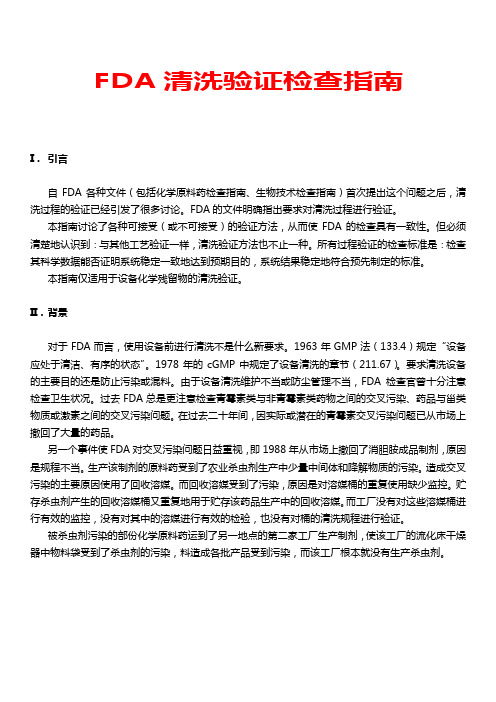
FDA清洗验证检查指南I.引言自FDA各种文件(包括化学原料药检查指南、生物技术检查指南)首次提出这个问题之后,清洗过程的验证已经引发了很多讨论。
FDA的文件明确指出要求对清洗过程进行验证。
本指南讨论了各种可接受(或不可接受)的验证方法,从而使FDA的检查具有一致性。
但必须清楚地认识到:与其他工艺验证一样,清洗验证方法也不止一种。
所有过程验证的检查标准是:检查其科学数据能否证明系统稳定一致地达到预期目的,系统结果稳定地符合预先制定的标准。
本指南仅适用于设备化学残留物的清洗验证。
II.背景对于FDA而言,使用设备前进行清洗不是什么新要求。
1963年GMP法(133.4)规定“设备应处于清洁、有序的状态”。
1978年的cGMP中规定了设备清洗的章节(211.67)。
要求清洗设备的主要目的还是防止污染或混料。
由于设备清洗维护不当或防尘管理不当,FDA检查官曾十分注意检查卫生状况。
过去FDA总是更注意检查青霉素类与非青霉素类药物之间的交叉污染、药品与甾类物质或激素之间的交叉污染问题。
在过去二十年间,因实际或潜在的青霉素交叉污染问题已从市场上撤回了大量的药品。
另一个事件使FDA对交叉污染问题日益重视,即1988年从市场上撤回了消胆胺成品制剂,原因是规程不当。
生产该制剂的原料药受到了农业杀虫剂生产中少量中间体和降解物质的污染。
造成交叉污染的主要原因使用了回收溶媒。
而回收溶媒受到了污染,原因是对溶媒桶的重复使用缺少监控。
贮存杀虫剂产生的回收溶媒桶又重复地用于贮存该药品生产中的回收溶媒。
而工厂没有对这些溶媒桶进行有效的监控,没有对其中的溶媒进行有效的检验,也没有对桶的清洗规程进行验证。
被杀虫剂污染的部份化学原料药运到了另一地点的第二家工厂生产制剂,使该工厂的流化床干燥器中物料袋受到了杀虫剂的污染,料造成各批产品受到污染,而该工厂根本就没有生产杀虫剂。
1992年,FDA对一家海外原料药生产厂发出了进口警告,该工厂使用同一设备生产强力甾类物质和非甾类物质。
FDA清洁验证检查指南(中英文对照)

FDA清洁验证检查指南(中英文对照)清洗过程验证检查指南GUIDE TOINSPECTIONS VALIDATION OF CLEANINGPROCESSES请注意:本指南是检查官和其他FDA人员的参考材料。
本指南不受FDA约束,并没有赋予任何人任何权利、特权、收益或豁免权。
I.介绍I. INTRODUCTION自从机构文件,包括原料药化学制剂检查指南和生物制剂检查指南,大体上提到该清洗问题以来,就出现了关于清洗过程验证的大量讨论。
这些机构文件清晰的建立了要验证的清洗过程需要达到的要求。
本指南是为了通过讨论实际操作是可接受的(或不可接受的),来建立检查要求的一致性和统一性。
同时,对清洗验证需要了解的是,像其他过程验证一样,可能有不止一种方法来对过程进行验证。
最后,任何验证过程的测试就是指科学数据是否显示出系统与要求相符和产生的结果是否符合预先定义的参数指标。
本指南只适用于化学残留物的设备清洗。
II.背景对于FDA来说,要求设备在使用前进行清洗并不新奇。
1963GMP 法规(部分133.4)中指出“设备***应该按照清洁和有序的方式进行维护***。
”在1978 CGMP法规中也包含了非常相似的有关设备清洗的章节(211.67)。
当然,清洁设备的主要理由是防止药品被污染或掺假。
在历史上,FDA检查官寻找由于对设备不当的清洗和维护和/或不良的灰尘控制系统而带来的总体不卫生情况。
而且,从历史上来说,FDA对非青霉素药品中的青霉素污染或药品中的活性激素或荷尔蒙交叉污染更加关注。
有很多药品在过去十年中被撤回就是因为实际的或潜在的青霉素的交叉污染。
导致FDA对由于不满足要求的过程导致交叉污染的可能性的进一步关注的案例是,1988年对成品药消胆胺树脂USP的撤回。
用于生产成品的原料药被生产农用杀虫剂中产生的中间体和降解物污染。
本案例中的交叉污染被认为是由于回收溶剂的重新使用。
回收溶剂由于缺乏对溶剂桶的重新使用的控制而被污染。
美国FDA清洗验证检查指南

美国FDA清洗验证检查指南注释:这份文件是检查员和其他FDA人员的参考资料。
这份文件不约束FDA,不授予任何人任何权力、特权、利益或豁免权。
Ⅰ. 简介对于清洗程序的验证的讨论,已经在FDA原料药检查指南和生物制品检查指南中有了简要地解释。
这些官方文件明确表达了清洗验证的期望。
本指南通过讨论一些可接受(或不可接受)的实例来建立检查的连贯性和一致性。
同时我们必须意识到清洗验证同其他过程的验证一样,都有不止一种的方法进行验证。
最后验证证明,是否有科学数据表明系统确实如预期稳定,并满足预设规定的结果。
这个指南仅涉及对设备化学残留物的清洗。
Ⅱ. 背景FDA对于设备使用前的清洗没有什么新要求,1963GMP规范中(133.4部分)有以下陈述“设备***应保持清洁和有序的状态***”。
在1978cGMP规范的设备清洁中有非常类似的章节。
当然,设备清洗的主要目的是为了防止药品的污染和混淆。
历史上,FDA 检查员发现由于设备的清洗和维护的不充分及不良的灰尘控制系统带来总体上的不卫生。
历史上来说,FDA更关注非青霉素类受青霉素类的污染和高活性的类固醇或激素对药物的交叉污染。
过去的几十年里,许多产品由于实际存在或潜在的青霉素交叉污染而召回。
1998年消胆胺树脂USP制剂的召回事件使FDA对由于不充分的清洗程序造成的潜在交叉污染更为重视。
产品生产中用到的化学原料药有低量的中间体和农业杀虫剂的降解物污染。
那个事件中交叉污染被认为来自回收溶剂的套用过程。
回收溶剂的污染是由于缺少对溶剂罐重复使用的控制。
杀虫剂生产过程中存放回收溶剂的罐子随后用于存放树脂生产过程中的回收溶剂。
公司对这些溶剂罐未严格管理,对存放的溶剂未充分检测,对罐子的清洗程序未验证。
杀虫剂污染了的原料药运到另一个地方提供给第二个工厂最后加工。
这对后一个工厂流化床干燥器上用到的捕尘袋造成杀虫剂污染。
这反过来导致在这里生产的多个批次交叉污染,而这里正常情况下没有杀虫剂生产。
FDA清洁验证指南
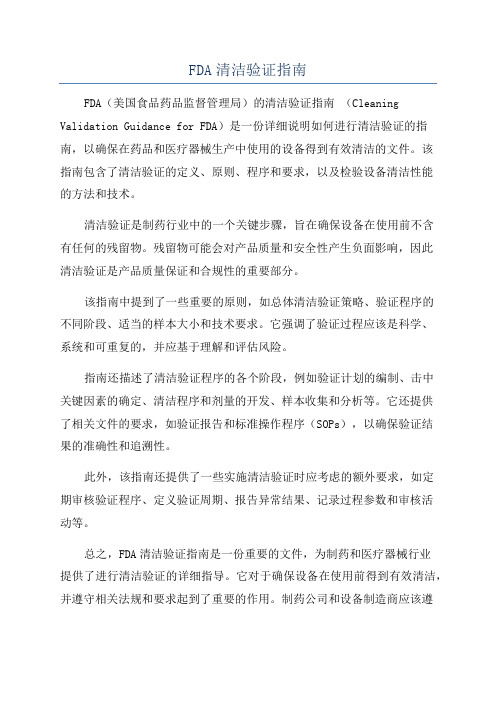
FDA清洁验证指南
FDA(美国食品药品监督管理局)的清洁验证指南(Cleaning Validation Guidance for FDA)是一份详细说明如何进行清洁验证的指南,以确保在药品和医疗器械生产中使用的设备得到有效清洁的文件。
该
指南包含了清洁验证的定义、原则、程序和要求,以及检验设备清洁性能
的方法和技术。
清洁验证是制药行业中的一个关键步骤,旨在确保设备在使用前不含
有任何的残留物。
残留物可能会对产品质量和安全性产生负面影响,因此
清洁验证是产品质量保证和合规性的重要部分。
该指南中提到了一些重要的原则,如总体清洁验证策略、验证程序的
不同阶段、适当的样本大小和技术要求。
它强调了验证过程应该是科学、
系统和可重复的,并应基于理解和评估风险。
指南还描述了清洁验证程序的各个阶段,例如验证计划的编制、击中
关键因素的确定、清洁程序和剂量的开发、样本收集和分析等。
它还提供
了相关文件的要求,如验证报告和标准操作程序(SOPs),以确保验证结
果的准确性和追溯性。
此外,该指南还提供了一些实施清洁验证时应考虑的额外要求,如定
期审核验证程序、定义验证周期、报告异常结果、记录过程参数和审核活
动等。
总之,FDA清洁验证指南是一份重要的文件,为制药和医疗器械行业
提供了进行清洁验证的详细指导。
它对于确保设备在使用前得到有效清洁,并遵守相关法规和要求起到了重要的作用。
制药公司和设备制造商应该遵
循该指南的要求,并根据需要进行相应的验证程序,以保证产品质量和安全性。
FDA清洁验证检查指南介绍 杨仲元
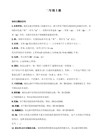
.
who is responsible for performing and approving the validation study, the
acceptance criteria,and when revalidation will be required.
析方法的灵敏度对限度的拟定很重要。
.
原料药生产,尤其是激素类,如果设备不是专用,应考虑副 产物的检测(如用色谱法)。
其限度设定是经科学证明的。
6 其他
.
(1)无效对照
.
用无效对照物相同条件下生产检查有无污染,结果不一定可靠,因为污染物分布不均匀的
问题
.
(2)洗涤剂
3 通则要求
.
FDA要求药厂应备有成同品种药品使用一种清洗规程,而更换产品时,对不同品种药品用另一种
方法清洗,要求有成文的说明。
3 通则要求
. 药厂用一种方法清洗水溶性残留物,用另一种方法清洗非水溶性残留物,成文的规程均应
FDA清洁验证检查指南介绍
GUIDE TO INSPECTIONS VALIDATION OF CLEANING PROCESSES
杨仲元
2009.8
该文件是作为参考文件,内容
包括:
1 引言
2 背景
3 通则要求
4 清洁验证的评估
5 限度的设定
6 其他
.
应容易完全冲洗掉
.
(3)清洗至合格为止
.
说明方法未经验证。
谢谢
management and which states whether or not the cleaning
FDA清洁过程验证的指导(英译)

一般要求:FDA专家已经为各种设备写了SOP细化清洁过程。
如果一个产品的不同批次有相同的清洁过程,产品变换时用不同的清洁过程。
我们希望这些不同的细节能被写下来。
同样,如果一个过程用于清洗水溶性残留,另一个过程用于清洗非水溶性残留,这些过程应该被写下来,并且要判断这个过程是否实施。
散装的药品决定了特定装备的特定化学生产过程,很难从设备上清洗的残留物和胶状残留。
流体干燥床是另一个常用于特定产品的难以清洗的设备的例子。
任何清洗过程中的残留(溶剂等)要从设备上清洁FDA专家要求有一个清洗过程的书面流程要被验证FDA专家当可接受的验证和重复验证被要求时,希望验证过程确认谁为过程负责,并推进验证研究FDA 专家要求准备在确认样品过程和包括这些方法的敏感性在内的分析方法的每一个生产系统中或单一设备在样品生产过程中的在进一步研究中写下验证参数。
FDA专家要求对应于参数和结果研究文件的验证研究。
FDA专家希望有被经理推进的和标明了是否清洁过程被验证的最后的验证报告。
数据应该支持残留物已经被降到一个“可接受的程度”的结论。
清洁验证的评估第一步聚焦于验证过程的目标,一些企业已经在发展这些目标时失败了。
在看到企业使用清洁过程的特殊样品和实验过程没有真正的评价在评价清洁过程时一些问题要被提出。
例如:一个设备或系统在何时变干净?需要用手清洁吗?是用手还是用溶剂清洗干净?主要的清洗过程一批到一批,一个产品到一个产品很显然吗?这些问题的答案对于检查很重要对于要决定过程的有效性的清洁过程的评估时很重要。
对于分辨提高有效措施何公司资源的结果的步骤这些答案也有帮助。
决定每个设备的清洗过程号。
一个设备或系统有一个清洁过程,然而这将依靠生产的品种,和是否同一产品的批次之间(在一个大的时间段或不同产品的批次间清除干净了。
当清洁过程在同一产品的不同批次间(在大的过程中的不同批量的同一中间体)最严格需要为达到一个标准,设备的“明显清洁”。
这些批次间的清洁不需要验证。
浅谈原料药FDA认证中的设备清洗验证
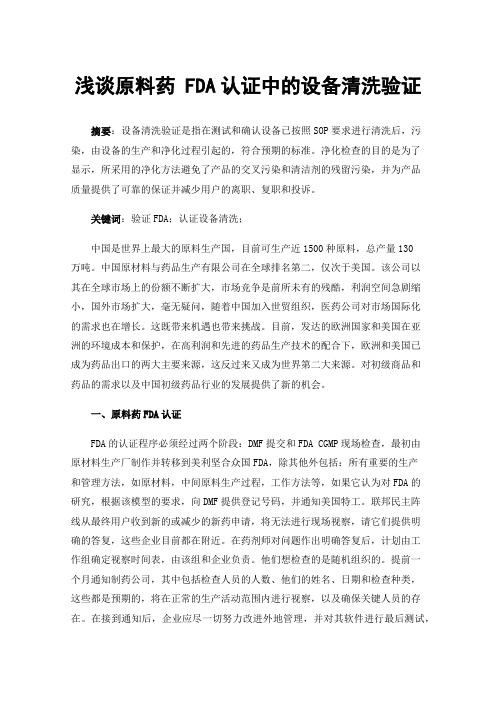
浅谈原料药 FDA认证中的设备清洗验证摘要:设备清洗验证是指在测试和确认设备已按照SOP要求进行清洗后,污染,由设备的生产和净化过程引起的,符合预期的标准。
净化检查的目的是为了显示,所采用的净化方法避免了产品的交叉污染和清洁剂的残留污染,并为产品质量提供了可靠的保证并减少用户的离职、复职和投诉。
关键词:验证FDA;认证设备清洗;中国是世界上最大的原料生产国,目前可生产近1500种原料,总产量130万吨。
中国原材料与药品生产有限公司在全球排名第二,仅次于美国。
该公司以其在全球市场上的份额不断扩大,市场竞争是前所未有的残酷,利润空间急剧缩小,国外市场扩大,毫无疑问,随着中国加入世贸组织,医药公司对市场国际化的需求也在增长。
这既带来机遇也带来挑战。
目前,发达的欧洲国家和美国在亚洲的环境成本和保护,在高利润和先进的药品生产技术的配合下,欧洲和美国已成为药品出口的两大主要来源,这反过来又成为世界第二大来源。
对初级商品和药品的需求以及中国初级药品行业的发展提供了新的机会。
一、原料药FDA认证FDA的认证程序必须经过两个阶段:DMF提交和FDA CGMP现场检查,最初由原材料生产厂制作并转移到美利坚合众国FDA,除其他外包括:所有重要的生产和管理方法,如原材料,中间原料生产过程,工作方法等,如果它认为对FDA的研究,根据该模型的要求,向DMF提供登记号码,并通知美国特工。
联邦民主阵线从最终用户收到新的或减少的新药申请,将无法进行现场视察,请它们提供明确的答复,这些企业目前都在附近。
在药剂师对问题作出明确答复后,计划由工作组确定视察时间表,由该组和企业负责。
他们想检查的是随机组织的。
提前一个月通知制药公司,其中包括检查人员的人数、他们的姓名、日期和检查种类,这些都是预期的,将在正常的生产活动范围内进行视察,以及确保关键人员的存在。
在接到通知后,企业应尽一切努力改进外地管理,并对其软件进行最后测试,以查明缺陷,并确保在检查期间严格遵守外勤支助部和综合安全分遣队的要求。
FDA审批医疗器械清洁验证方案
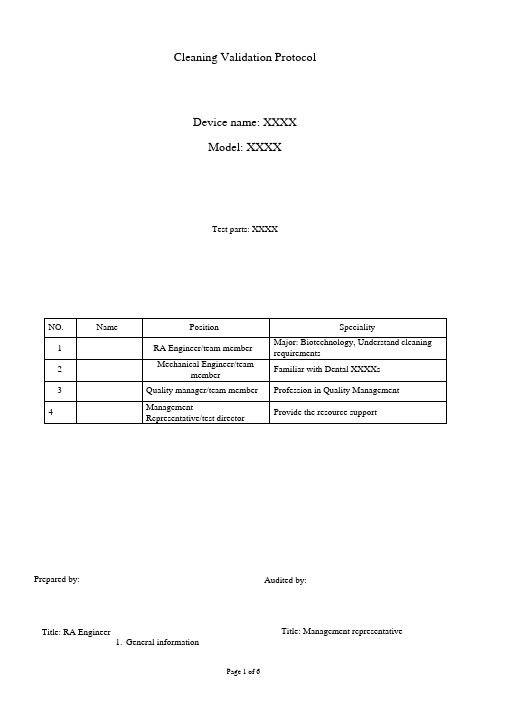
Cleaning Validation ProtocolDevice name: XXXX Model: XXXXTest parts: XXXXPrepared by:Title: Management representative1. General informationAudited by:Title: RA EngineerProtocol No.: XXX-01Sponsor: XXXX Limited.Add: XXXX China.Test director: XXXTest personal : XXXTest objective: Validate the efficacy of cleaning method (manual cleaning) provided in user manual for XXXX. Test sample: XXXX, see table 1Test Lab: XXXX LimitedReference:AAMI TIR12:2010 Designing, Testing, and Labeling Reusable Medical Devices for Reprocessing in Health Care Facilities. A Guide for Device Manufacturers 1st ed.AAMI TIR30:2011 A Compendium of Processes, Materials, Test Methods, and Acceptance Criteria for Cleaning Reusable Medical Devices.Alfa MJ, Degagne P, Olson N. Worst-case soiling levels for patient used flexible endoscopes before and after cleaning. Am J Infect Control 1999;27:392-401.ASTM D7225-13 Standard Guide for Blood Cleaning Efficiency of Detergents and Washer-disinfectorsReprocessing Medical Devices in Health Care Settings: Validation Methods and Labeling Guidance for Industry and Food and Drug Administration Staff. March 17, 2015User manual of XXXX2.IntroductionThis protocol details the methods to be used to validate the effectiveness of a manual cleaning procedure for the XXXX.The device will be inoculated with an artificial test soil in various areas including those considered to be most challenging to clean and most likely to be soiled during actual use. The device then will be processed in accordance with the cleaning procedure delineated in section 5. the device will be assayed and residual blood will be recovered to determine if adequate cleaning was achieved.This testing will be repeated for a total of three (3) test cycles.3.JUSTIFICATIONThis test method was based on methods outlined in AAMI TIR30:2011 and ASTM D7225-13 .Cleaning instructions for reusable medical devices require validation in order to assure proper and safe reprocessing of the devices by healthcare facilities. It is well known that a device which has not been cleaned properly may inhibit the ability of the sterilization process to achieve the proper sterility assurance level. This cleaning procedure must be able to remove gross amounts of soil from the test device in order for it to be determined clean and safe for further processing. This study will attempt to verify that gross amounts of soil can be removed from the device following the recommended cleaning procedure.The artificial test soil used to inoculate the device will simulate worst case contaminants (blood and human saliva) that may come in contact with the device and remain on the device after clinical use. The device will be soiled using the artificial test soil and inoculated in the most difficult to clean locations and areas most likely to be soiled during actual use. The least effective (lowest) cleaning temperatures (according to the using temperature) within recommendations etc. These procedures will provide worst case soiling conditions for the cleaning validation.Acceptance criteria : no obvious stain under visual Observation, and will be based on study data of residual blood levels of properly cleaned medical instruments which indicate that after cleaning, the level of blood < 0.1 g/deviceon the device after performing the recommended cleaning procedure will indicate adequate cleaning and demonstrate that the cleaning method is efficacious in removing soil .4.EQUIPMENT AND MATERIALS1)XXXX: XXXX2)Detergent: 75% alcohol3)Rabbit blood4)Human saliva5)Solution 1--0.1%Tetramethylbenzidine (TMB) in 5% acetic acid, solution 2--3% hydrogen peroxidesolution, used for blood Analysis6)Swab7)Timer8)Thermometer9)Soft cloth10)soft brush5.Cleaning5.1Preparation of artificial test soilThe artificial test soil will contain the following components to mimic blood and saliva:2.5 ml rabbit blood2.5 ml physiological saline5 ml human saliva5.2Cleaning validation Procedure1)The devices listed in Table 1 will be obtained. See Table 2 for testing sample sizes.2)Prior to testing, all devices will be pre-cleaned following steps 5).3)The test samples will be inoculated in the most difficult to clean locations and areas most likely to be soiledduring actual use with the prepared artificial test soil, see Figure 1 for the device inoculation description.4)The inoculated test samples will be allowed to dry at room temperature for a minimum of two (2) hours tosimulate worst case conditions. A photo of the soiled devices will be included in the final report.5)Head cleaning (for Each test sample and negative control):a.Remove dirt and debris from the water spray outlets with a soft brush,b.Fill a cup halfway with clean water,c.Activate the XXXX and immerse into water whilst bur is rotating,d.Start and stop rotating the bur for 2 to 3 seconds 3 times whilst the head remains in the water. Remove andwipe dry with a clean soft cloth.XXXX cleaning(for Each test sample and negative control)a.Rinse the device under running cold tap water and hand wash the full surface of the device until no obviousdirty.b.Wipe the device with a water soaked soft cloth.c.Wipe clean with alcohol-immersed cotton swab or cloth, ensuring contact with difficult to clean areas suchas chuck holes,crevices etc.6)The test samples and negative control will be visually inspected. If visual soil remains, steps 5) will be repeateduntil test devices are visibly clean.7)Steps 3) through 6) will be repeated three additional times for a total of four repetitive inoculation and cleaningcycles to simulate soil accumulation that might occur during actual use.8)Steps 3) and 4) will be repeated for the positive control.9)Sample the whole XXXX surface with swab, especially the areas difficult to clean, such as chuck holes,crevicesetc. (Use the clean cotton swab that does not react with the test solution. If surfaces are dry, swab should be moistened with a drop of water. If the surface is wet, the swab need not be pre-moistened)10)Activate 1 ml of solution1 with 100 l of solution 2 and drop the swab in the liquid. Blood residue will beindicated by a blue color reaction. Visible color change will occur at 0.1 g or greater. Repeated the step 9) through 10) until get all results of these samples.11)Results, equipment, lot numbers, and other pertinent information will be record and issued in the final report.Device soiling descriptions:Figure 1Using gloved hands soiled with artificial test soil, the surface of the device will be handled, ensuring contact with difficult clean areas such as chuck hole,crevices .6.0 Acceptance Criteria6.1 Each test sample shall be free of visible soil after cleaning.6.2Each test sample shall produce a blood level of less than 0.1 g/device after cleaning.5.0 Final ReportThe test report shall include but not limited: name and address of test institution, name of test personnel, start and end time, description of the test sample, test methods, observations, as well as the results of other necessary information, etc.。
清洁验证指南
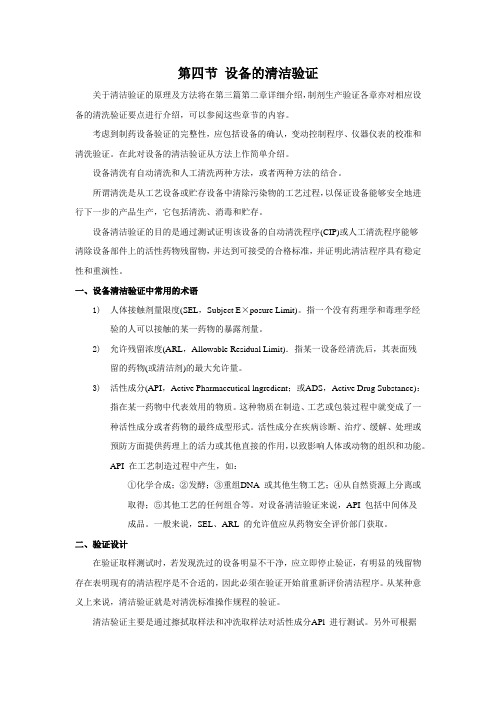
第四节设备的清洁验证关于清洁验证的原理及方法将在第三篇第二章详细介绍,制剂生产验证各章亦对相应设备的清洗验证要点进行介绍,可以参阅这些章节的内容。
考虑到制药设备验证的完整性,应包括设备的确认,变动控制程序、仪器仪表的校准和清洗验证。
在此对设备的清洁验证从方法上作简单介绍。
设备清洗有自动清洗和人工清洗两种方法,或者两种方法的结合。
所谓清洗是从工艺设备或贮存设备中清除污染物的工艺过程,以保证设备能够安全地进行下一步的产品生产,它包括清洗、消毒和贮存。
设备清洁验证的目的是通过测试证明该设备的自动清洗程序(CIP)或人工清洗程序能够清除设备部件上的活性药物残留物,并达到可接受的合格标准,并证明此清洁程序具有稳定性和重演性。
一、设备清洁验证中常用的术语1)人体接触剂量限度(SEL,Subject E×posure Limit)。
指一个没有药理学和毒理学经验的人可以接触的某一药物的暴露剂量。
2)允许残留浓度(ARL,Allowable Residual Limit).指某一设备经清洗后,其表面残留的药物(或清洁剂)的最大允许量。
3)活性成分(API,Active Pharmaceutical lngredient;或ADS,Active Drug Substance):指在某一药物中代表效用的物质。
这种物质在制造、工艺或包装过程中就变成了一种活性成分或者药物的最终成型形式。
活性成分在疾病诊断、治疗、缓解、处理或预防方面提供药理上的活力或其他直接的作用,以致影响人体或动物的组织和功能。
API 在工艺制造过程中产生,如:①化学合成;②发酵;③重组DNA 或其他生物工艺;④从自然资源上分离或取得;⑤其他工艺的任何组合等。
对设备清洁验证来说,API 包括中间体及成品。
一般来说,SEL、ARL 的允许值应从药物安全评价部门获取。
二、验证设计在验证取样测试时,若发现洗过的设备明显不干净,应立即停止验证,有明显的残留物存在表明现有的清洁程序是不合适的,因此必须在验证开始前重新评价清洁程序。
2、清洁验证

1、残留物如何确定?
2、残留物限度规格制定?
3、分析方法如何验证? 4、日常监控如何实施?
限度和可接受标准制定原则:
1、实际的 2、可以被验证的 3、可实现的 4、能够经得起科学推敲的
PDA技术报告:1998增刊52卷 第6号
限度规格制定的三个层面:
1、目检(肉眼检测) 2、化学检验 3、微生物检验
*
MTDD = 每次给药数X活性成分含量X每日最少给药次数
允许残留物总量(μg/ cm2 ) =
MTDD X 最小生产批量 X 1000 单个制剂质量X每日最多使用制剂数X设备内表面积
安全系数:
药品种类
外用药 口服制剂
系数设置
1/10 ~ 1/100 日治疗剂量 1/100 ~ 1/1000 日治疗剂量
举例:产品一般信息描述
产品名称
活性物料API信息
API1 worst-case评价参数 1、水中溶解性 单位 1g → X ml mg/kg API2 API3 API4
产品1
产品2
产品3
产品4
2、大鼠经口LD50
3、日治疗量
4、目检有效性
mg
清洗难度 一般 容易 较易 很难
二、清洁验证的关注点
针剂、注射剂
开发中药物
1/1000 ~ 1/10000 日治疗剂量
1/10000 ~ 1/100000 日治疗剂量
PDA技术报告:1998增刊52卷 第6号
(3)残留溶剂限度标准:
可用于清洗的化学溶剂 (三级溶剂) 在下 批生产中允许的溶剂残留小于初始溶剂 浓度的0.5%。
特殊产品的限度:
特殊产品,如致敏性产品(青霉素、头孢 类)或高活性产品在使用最好的检测手段 的前提下,不应被检出。 实际上意味着对于这类产品需要采用专用 生产设施。
- 1、下载文档前请自行甄别文档内容的完整性,平台不提供额外的编辑、内容补充、找答案等附加服务。
- 2、"仅部分预览"的文档,不可在线预览部分如存在完整性等问题,可反馈申请退款(可完整预览的文档不适用该条件!)。
- 3、如文档侵犯您的权益,请联系客服反馈,我们会尽快为您处理(人工客服工作时间:9:00-18:30)。
FDA清洗验证检查指南I.引言自FDA各种文件(包括化学原料药检查指南、生物技术检查指南)首次提出这个问题之后,清洗过程的验证已经引发了很多讨论。
FDA的文件明确指出要求对清洗过程进行验证。
本指南讨论了各种可接受(或不可接受)的验证方法,从而使FDA的检查具有一致性。
但必须清楚地认识到:与其他工艺验证一样,清洗验证方法也不止一种。
所有过程验证的检查标准是:检查其科学数据能否证明系统稳定一致地达到预期目的,系统结果稳定地符合预先制定的标准。
本指南仅适用于设备化学残留物的清洗验证。
II.背景对于FDA而言,使用设备前进行清洗不是什么新要求。
1963年GMP法(133.4)规定“设备应处于清洁、有序的状态”。
1978年的cGMP中规定了设备清洗的章节(211.67)。
要求清洗设备的主要目的还是防止污染或混料。
由于设备清洗维护不当或防尘管理不当,FDA检查官曾十分注意检查卫生状况。
过去FDA总是更注意检查青霉素类与非青霉素类药物之间的交叉污染、药品与甾类物质或激素之间的交叉污染问题。
在过去二十年间,因实际或潜在的青霉素交叉污染问题已从市场上撤回了大量的药品。
另一个事件使FDA对交叉污染问题日益重视,即1988年从市场上撤回了消胆胺成品制剂,原因是规程不当。
生产该制剂的原料药受到了农业杀虫剂生产中少量中间体和降解物质的污染。
造成交叉污染的主要原因使用了回收溶媒。
而回收溶媒受到了污染,原因是对溶媒桶的重复使用缺少监控。
贮存杀虫剂产生的回收溶媒桶又重复地用于贮存该药品生产中的回收溶媒。
而工厂没有对这些溶媒桶进行有效的监控,没有对其中的溶媒进行有效的检验,也没有对桶的清洗规程进行验证。
被杀虫剂污染的部份化学原料药运到了另一地点的第二家工厂生产制剂,使该工厂的流化床干燥器中物料袋受到了杀虫剂的污染,料造成各批产品受到污染,而该工厂根本就没有生产杀虫剂。
1992年,FDA对一家海外原料药生产厂发出了进口警告,该工厂使用同一设备生产强力甾类物质和非甾类物质。
该工厂是多品种原料药生产厂。
FDA认为交叉污染的可能性很大,对公众的健康造成了严重威胁。
该工厂仅在FDA检查时开始清洗验证工作,FDA在检查时认为该清洗验证不当。
理由之一是:工厂仅寻找没有前一种物质存在的证据。
但是用TLC法检验洗涤水之后,找到了设备中还残留了前一产品生产过程中的副反应物质和降解物质的证据。
III.清洗验证的要求通则FDA要求:建立书面标准操作程序(SOP),其中必须详细规定设备各部件的清洗过程。
若同一产品、不同批号的清洗使用一种方法,而更换品种时使用另一种清洗方法,应在书面规程中说明清洗方法的不同之处。
同样,若水溶性残留物质与非水溶性残留物质的清洗方法不同,则书面规程中也应对两种方法进行说明,必须明确规定在什么情况下执行哪一种清洗方法。
化学原料药生产中产生柏油状或粘胶状残留物质的某些生产工序,可考虑使用专用设备。
流化床干燥器物料袋也是一种难以清洗的设备,通常也只用于一种产品的生产。
清洗过程本身产生的所有残留物质(洗涤剂、溶媒、等)也必须从设备中除去。
FDA要求:必须建立书面的清洗方法验证通则。
FDA要求:清洗方法验证通则应规定执行验证的负责人、批准验证工作的负责人、验证标准(合格标准)、再验证的时间。
FDA要求:对各生产系统或各设备部件进行清洗验证之前,应制定专一特定的书面验证计划,其中应规定取样规程、分析方法(包括分析方法的灵敏度)。
FDA要求:按上述验证计划进行验证工作,记录验证结果。
FDA要求:做出最终的验证报告,报告应由有关管理人员批准,并说明该清洗方法是否有效。
报告中的数据应支持结论,即:“残留物质已经减少到了’可接受的限度’”。
IV.清洗验证的评价(检查)首先,应重点关注验证过程的目的。
我们曾遇到过有些公司就没有建立验证的目的。
很多工厂在验证时取了大量的样品,做了大量的检验,却没有对清洗各步操作的效果做出真正的评价。
评价清洗方法时,应注意几个问题:如,设备部件或设备系统到什么程度才算清洁?是否必须要用手擦洗?用手擦洗而不用溶媒清洗会得到什么效果?人工清洗时,批与批之间、不同之间有多大差异?评价和检查清洗方法时,这些问题都十分重要,因为检查官必须确定该清洗方法的效果(有效性)。
而且这些问题也有助于省去多余的步骤而有效地工作,从而为公司节约资源。
检查每个设备部件有几种清洗方法。
理想地说,一个设备部件或一个系统只有一种清洗方法,但这还取决于生产的品种,以及同一品种不同批号之间、或不同品种之间是否需要清洗。
若该清洗方法只用于同一品种不同批号(或同一种中间体的不同批号),则只需要达到“目视清洁”的标准即可,这种批与批之间的清洗不需要验证。
1.设备的型式检查设备的型式,尤其是使用半自动或全自动现场清洗(CIP,Clean-in-place)系统的大型生产系统,需要重点检查。
如,应该使用没有球阀的卫生型管道系统。
若使用了非卫生型的球阀(这在原料药生产中很普遍),清洗就会十分困难。
若在现场检查中发现使用了上述类型的设备系统,清洗操作人员必须对这种问题有所认识,必须经过特殊培训,从而能够正确清洗系统和阀门。
要检查操作工人对设备系统的了解程度、培训水平和现场清洗操作的经验。
还要检查书面的、验证后的清洗方法,从而确定设备系统的清洗得到了正确的验证。
对于大型系统,如,使用长输送管道的设备,要检查流程图和管线图,从而确定需要清洗的阀门以及是否有书面的清洗规程。
需要清洗的管道和阀门应做出标记,易于操作人员识别。
阀门标识不当(无论是图纸还是实物)均会导致清洗不正确。
必须检查清洗记录是否记录了关键因素。
检查生产工序结束至清洗开始的时间长短,这对于外用剂、悬浮剂和原料药的生产尤为重要。
因为残留物质干燥后,会直接影响清洗的效果。
无论是否使用现场在线清洗装置,都应考虑检查设备清洗中的微生物菌情况。
这需要很多预防措施,而不是在染菌之后再除菌。
应有证据证明:设备的日常清洗和贮存不会繁殖微生物菌。
如,设备贮存之前应进行干燥,清洗后的积水绝不能遗留在设备中。
清洗之后,会对设备进行消毒(虽然设备可能是用于无菌生产或非无菌生产,但产品会产生微生物菌)。
虽然本指南不针对消毒过程,但仍应注意检查清洗过程和贮备过程对微生物菌的控制程度,从而保证在后续的消毒过程中能够达到无菌规定要求。
从无菌生产中热原控制要求方面而言,这一点也十分重要。
因为设备消毒无法使大量热原灭活或除去大量热原。
2.书面清洗规程规程和记录:要检查验证后的清洗方法是否专一、详细,检查需要记录的项目。
我们曾见过许多SOP通则,涉及了许多批生产记录,其中要求对每一步操作做出专门的记录。
系统的复杂程度不同,清洗方法以及操作人员培训程度和能力也不同,各种清洗工作或规程记录的数量也会有不同。
需要进行更为复杂的清洗记录时,必须对关键的清洗工序做出记录(如,某些原粉合成工序),应有专门的设备记录,包括清洗人员姓名、清洗时间。
相对简单的清洗工作仅记录“全部清洗工作已经执行”就足够了。
其他因素,如清洗历史、清洗后测出的残留物水平、检验结果的可变性等有时也要记录。
如,清洗之后,残留物含量具可变性,而又认定该清洗方法是可接受的,则必须证明清洗过程和工人操作的有效性。
必须对清洗方法做出正确的评价,尤其是认为工人操作有问题时,就更要求做出更为详细的记录,进行更多的培训。
3.分析方法应检查残留物或污染物分析方法的专一性和灵敏度。
借助于先进的分析技术,清洗和生产过程中极少的残留物或污染物也能够被检查出来。
检验不出污染物或残留物浓度,并不能说明清洗之后不存在残留物污染物,而只说明样品中没有分析方法灵敏度之内或检验限量之内的污染物。
工厂应对分析方法进行挑战性实验,即:证明取样方法能够从设备表面取到污染物,其收率是多少,如50%, 90%等。
根据取样结果再做出结论。
取样技术不当也会得出相反的结论(见下述)。
4取样:可接受方法有的两种。
最好是直接从设备表面取样。
另一种方法是取漂洗水样。
a. 表面直接取样法检查取样的类型,以及对检验数据的影响。
取样器具可能会干扰检验结果。
如,已发现取样拭上的粘胶会干扰样品的分析。
在验证初期,必须保证使用适当的取样介质和溶媒(用于从取样介质中提取样品),并且方便使用。
直接取样法的优点在于:能够对最难清洗、能够到达的表面清洗程度进行评价,从而确定选定的单位面积上残留物/污染物含量。
此外,还能够取到“干燥”后或不溶性残留物样品。
b. 漂洗液样品具有两点优势:能够对较大表面积进行取样;能够对到达不到的系统或日常工作无法拆卸的部位取样并做出评价。
其缺陷是:残留物或污染物可能是不溶性或吸藏在设备中。
此时,可使用“脏点”类推法进行评价,干燥的残留物检验,更不能检测漂洗水样,而是检查“脏点”,从而确定清洗是否干净。
通过检验漂洗水样来验证清洗方法时,应检查是否直接检验了漂洗水样中的残留物或污染物。
若仅检测漂洗水样的水质情况,而不测定可能存在的污染物含量,这种做法是不能接受的。
c. 日常生产的中间控制进行监测:分析方法得到验证之后,日常检验可使用间接检验法,如电导率项目测定。
由于原料药生产使用了反应罐和离心机,大型设备之间用管道连接,因此只能取漂洗水样。
这种情况下,日常检验更需采用间接检验法。
但必须证明间接检验法与设备状况的相关性。
应验证并有书面证据证明:用间接法检验未清洗设备时,检验结果能够证明设备不能使用以及未清洗。
即:该检验结果能够得出不能够接受当前设备状况的结论。
V.残留物/污染物限量的建立对于清洗方法是否得到了验证,FDA不打算建立统一的判断标准,这也没有意义。
因为原料药、制剂生产的品种范围太多。
工厂应根据自身对该药品的理解确定合理的残留限量,该限量应是实际可测的。
工厂还应证明分析方法的灵敏度,这一点十分重要。
工业界已提出分析检测的限量标准,如:10ppm;生物活性检测限量标准,如正常治疗剂量的1/1000;或感官限量标准,如“无视在残留物”,等等。
要检查建立残留限量标准的方式。
在这方面,原料药与制剂不同。
制剂生产是已知残留物的化学名称(如来自于活性成份、非活性成份、洗涤剂等),而原料药可能会无法得知,会有部份反应物和其他副产物。
仅注意重要反应物的残留限量是不够的,因为其他化学变量可能更难以除去。
此时,除化学分析之外,可能还需要TLC法。
原料药生产中,尤其是强力化学药物,如甾类物质,若不使用专用设备,就必须考虑副产物残留量的问题。
检查的目的是保证所有限量的规定有科学的依据。
VI.其他问题a. 无效对照剂评价和验证清洗方法时,有些工厂在相同设备、相同操作参数下生产无效对照剂进行验证。
然后检验分析该批无效对照剂,测定是否受到了上批药品残留物的污染。
但是,我们已经记录了使用无效对照剂验证的几个问题。
